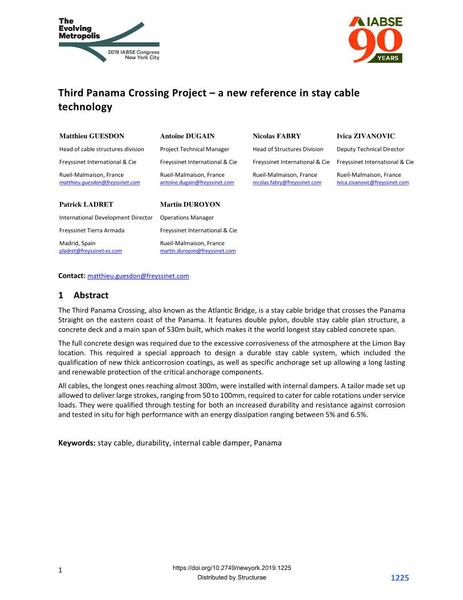Third Panama Crossing Project – a new reference in stay cable technology

|
|
|||||||||||
Bibliografische Angaben
| Autor(en): |
Matthieu Guesdon
(Freyssinet International & Cie)
Antoine Dugain (Freyssinet International & Cie) Nicolas Fabry (Freyssinet International & Cie) Ivica Zivanovic (Freyssinet International & Cie) Patrick Ladret (Freyssinet International & Cie) Martin Duroyon (Freyssinet International & Cie) |
||||
|---|---|---|---|---|---|
| Medium: | Tagungsbeitrag | ||||
| Sprache(n): | Englisch | ||||
| Tagung: | IABSE Congress: The Evolving Metropolis, New York, NY, USA, 4-6 September 2019 | ||||
| Veröffentlicht in: | The Evolving Metropolis | ||||
|
|||||
| Seite(n): | 1225-1230 | ||||
| Anzahl der Seiten (im PDF): | 6 | ||||
| DOI: | 10.2749/newyork.2019.1225 | ||||
| Abstrakt: |
The Third Panama Crossing, also known as the Atlantic Bridge, is a stay cable bridge that crosses the Panama Straight on the eastern coast of the Panama. It features double pylon, double stay cable plan structure, a concrete deck and a main span of 530m built, which makes it the world longest stay cabled concrete span. The full concrete design was required due to the excessive corrosiveness of the atmosphere at the Limon Bay location. This required a special approach to design a durable stay cable system, which included the qualification of new thick anticorrosion coatings, as well as specific anchorage set up allowing a long lasting and renewable protection of the critical anchorage components. All cables, the longest ones reaching almost 300m, were installed with internal dampers. A tailor made set up allowed to deliver large strokes, ranging from 50 to 100mm, required to cater for cable rotations under service loads. They were qualified through testing for both an increased durability and resistance against corrosion and tested in situ for high performance with an energy dissipation ranging between 5% and 6.5%. |
||||
| Stichwörter: |
Dauerhaftigkeit Schrägkabel
|
||||
